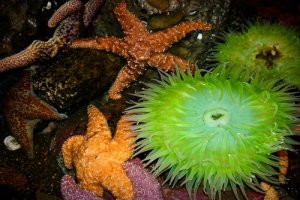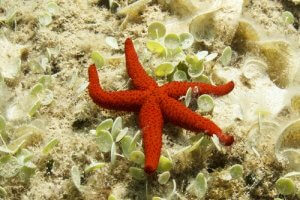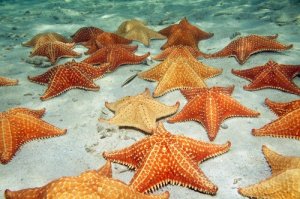The Echinoderms: 6 Things You Should Know


Written and verified by biochemistry Luz Eduviges Thomas-Romero
The echinoderms are a group of marine invertebrates. This group includes some of the most iconic marine animals in the world, from sea urchins and starfish, to sea lilies.
The name echinoderm literally means “spiny skin”. Although not all members of this group actually have spines, it’s true that the majority do have very rough skin. Some species also have toxic spines, which they can use as a defense mechanism against predators.
There is a common misconception that echinoderms have an exoskeleton. However, the structure that we see, and that provides the animal with both protection and rigidity, isn’t actually external. In fact, it’s made up of plates of calcium carbonate – with or without spines – which are covered by a thin layer of skin. Because the plates located beneath the skin, it is classified as having an endoskeleton.
The epidermis contains pigment cells that give echinoderms their characteristically bright color.
These invertebrates have many distinctive characteristics. In this article, we’ll tell you six fascinating facts about the echinoderms.
1. Radial symmetry – a unique echinoderm trait
Pentaradial symmetry is when the body is made up of five identical sections, each with an identical set of internal organs, that radiate from a single central point. This trait can only be observed in adult echinoderms.
Although in some species, external pentamerous symmetry has been lost, the symmetrical distribution of their internal organs remains the same.

2. Echinoderms can regenerate parts of their body
These creatures have the remarkable ability to regenerate parts of their body, including both internal organs, and external limbs. If they lose one of their limbs in an attack, many echinoderms can gradually regenerate the missing limb once the wound has healed.
Some species can even use regeneration to reproduce. The animal deliberately splits itself in two. Each half then regenerates any missing limbs to form a completely new organism.
3. Echinoderms don’t have blood
Echinoderms don’t have blood or a heart. Instead, they have a mechanism which is unique to these unusual creatures: a water vascular system that carries oxygen to their vital organs. This hydraulic system is also known as the ambulacral or the aquiferous system.
This system is made up of canals which transport seawater around the body. These canals are found in the echinoderm’s feet, and are known as tube feet. They often have small suckers on the end.
These feet have a wide range of uses, including gas exchange, feeding, movement and detection of external stimuli. This system typically opens to the exterior through an opening known as the madreporite, which is connected to the mouth.
4. They breathe through their feet
In general, echinoderms breathe by drawing seawater in through their tube feet. These tubes transport oxygenated water around the rest of the body. The dermal bronchae in their skin also allow gas exchange with their environment.
5. Some echinoderms eat by extending their stomachs out through their mouths
Diet can vary greatly from species to species. Generally speaking, echinoderms have a mouth, esophagus, stomach and intestine, and they may or may not have an anus. Curiously, echinoderms such as starfish digest their prey by extending their stomachs out through their mouths.

Many echinoderms, including starfish, prefer to live on a diet of shellfish. They use their ambulacral feet to grab hold of, and prise open, the shells. Then, they extend their stomach toward the open shell, secrete digestive juices to dissolve the contents, and then draw back their stomach, along with its liquefied meal.
6. They don’t have eyes
One of the most interesting things about echinoderms is they don’t have eyes or a brain, just a rudimentary nervous system. However, many starfish have light-sensitive organs on their arms. These simple organs, known as eyespots, don’t receive detailed images, but they can perceive different levels of light. Experts believe that they allow starfish to orientate themselves and direct themselves to where they want to go.
So, as you can see, echinoderms are truly fascinating creatures. However, they are also important for maintaining the planet’s ecological and geological balance. As a result, many conservation groups are working to preserve the echinoderms’ natural biodiversity.
The echinoderms are a group of marine invertebrates. This group includes some of the most iconic marine animals in the world, from sea urchins and starfish, to sea lilies.
The name echinoderm literally means “spiny skin”. Although not all members of this group actually have spines, it’s true that the majority do have very rough skin. Some species also have toxic spines, which they can use as a defense mechanism against predators.
There is a common misconception that echinoderms have an exoskeleton. However, the structure that we see, and that provides the animal with both protection and rigidity, isn’t actually external. In fact, it’s made up of plates of calcium carbonate – with or without spines – which are covered by a thin layer of skin. Because the plates located beneath the skin, it is classified as having an endoskeleton.
The epidermis contains pigment cells that give echinoderms their characteristically bright color.
These invertebrates have many distinctive characteristics. In this article, we’ll tell you six fascinating facts about the echinoderms.
1. Radial symmetry – a unique echinoderm trait
Pentaradial symmetry is when the body is made up of five identical sections, each with an identical set of internal organs, that radiate from a single central point. This trait can only be observed in adult echinoderms.
Although in some species, external pentamerous symmetry has been lost, the symmetrical distribution of their internal organs remains the same.

2. Echinoderms can regenerate parts of their body
These creatures have the remarkable ability to regenerate parts of their body, including both internal organs, and external limbs. If they lose one of their limbs in an attack, many echinoderms can gradually regenerate the missing limb once the wound has healed.
Some species can even use regeneration to reproduce. The animal deliberately splits itself in two. Each half then regenerates any missing limbs to form a completely new organism.
3. Echinoderms don’t have blood
Echinoderms don’t have blood or a heart. Instead, they have a mechanism which is unique to these unusual creatures: a water vascular system that carries oxygen to their vital organs. This hydraulic system is also known as the ambulacral or the aquiferous system.
This system is made up of canals which transport seawater around the body. These canals are found in the echinoderm’s feet, and are known as tube feet. They often have small suckers on the end.
These feet have a wide range of uses, including gas exchange, feeding, movement and detection of external stimuli. This system typically opens to the exterior through an opening known as the madreporite, which is connected to the mouth.
4. They breathe through their feet
In general, echinoderms breathe by drawing seawater in through their tube feet. These tubes transport oxygenated water around the rest of the body. The dermal bronchae in their skin also allow gas exchange with their environment.
5. Some echinoderms eat by extending their stomachs out through their mouths
Diet can vary greatly from species to species. Generally speaking, echinoderms have a mouth, esophagus, stomach and intestine, and they may or may not have an anus. Curiously, echinoderms such as starfish digest their prey by extending their stomachs out through their mouths.

Many echinoderms, including starfish, prefer to live on a diet of shellfish. They use their ambulacral feet to grab hold of, and prise open, the shells. Then, they extend their stomach toward the open shell, secrete digestive juices to dissolve the contents, and then draw back their stomach, along with its liquefied meal.
6. They don’t have eyes
One of the most interesting things about echinoderms is they don’t have eyes or a brain, just a rudimentary nervous system. However, many starfish have light-sensitive organs on their arms. These simple organs, known as eyespots, don’t receive detailed images, but they can perceive different levels of light. Experts believe that they allow starfish to orientate themselves and direct themselves to where they want to go.
So, as you can see, echinoderms are truly fascinating creatures. However, they are also important for maintaining the planet’s ecological and geological balance. As a result, many conservation groups are working to preserve the echinoderms’ natural biodiversity.
All cited sources were thoroughly reviewed by our team to ensure their quality, reliability, currency, and validity. The bibliography of this article was considered reliable and of academic or scientific accuracy.
- Hernández Ramírez, P. (2006). Regeneración biológica: Secretos de la naturaleza. Revista Cubana de Hematología, Inmunología y Hemoterapia, 22(3), 0-0.
- Martín, A. O., Tocino, L. S., & González, S. L. (1999). Guía submarina de invertebrados no artrópodos. Editorial Comares.
- Zamora, S. (2011). Equinodermos del Cámbrico de España: situación actual de las investigaciones y perspectivas futuras. Estudios geológicos, 67(1), 59-81.
This text is provided for informational purposes only and does not replace consultation with a professional. If in doubt, consult your specialist.








